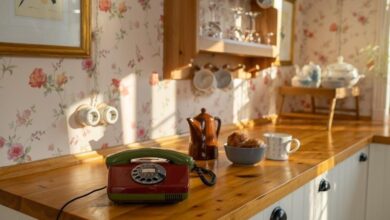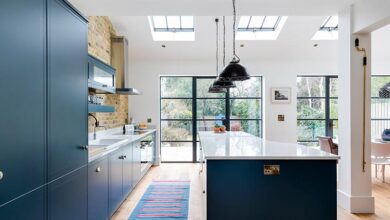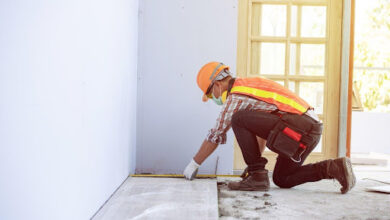How to Pair Living Room End Tables with Your Sofa: Tips for Perfect Harmony

Have you ever walked into a living room and felt something was slightly off, but couldn’t quite put your finger on it? The secret might be hiding in the relationship between your sofa and end tables.
Interior design is an intricate dance of proportion, style, and functionality, where every piece tells a story of harmony or discord. The right end tables can transform a living space from ordinary to extraordinary.
They’re not just functional surfaces but essential design elements that bridge the gap between form and function. These simple pieces carry the power to elevate your entire room’s aesthetic.
Understanding Room Dynamics
Home design requires a nuanced approach to furniture selection and placement. Interior designers understand that furniture pieces must communicate with each other, creating a cohesive visual narrative.
The relationship between sofas and end tables is critical in establishing room balance. Home decor enthusiasts often overlook the importance of proportional relationships. Living room end tables create visual balance and functional support for your seating areas. These essential pieces serve as both practical surfaces and design anchors that connect different elements of your living space.
Choosing the Right Size and Scale
Proportion remains the cornerstone of successful furniture pairing. End tables should complement your sofa’s size, height, and overall design aesthetic.
A well-chosen end table creates visual symmetry and enhances the room’s functional design. Measuring is critical when selecting end tables for your living space. Professional designers recommend end tables with the same height as your sofa’s arm or fall within two inches above or below. This ensures a harmonious visual relationship and practical functionality.
Style and Material Considerations
Furniture styles communicate a room’s personality and design intention. Modern minimalist sofas pair differently with end tables compared to traditional, plush seating arrangements. Understanding these nuanced relationships helps create a cohesive design narrative. Key considerations include:
- Material compatibility with existing furniture
- Color coordination and contrast
- Architectural style of the room
- Personal design preferences
Functional Design Strategies
Functionality should never be sacrificed for aesthetic appeal. End tables must serve practical purposes beyond visual harmony.
Consider storage needs, surface area requirements, and how the tables will be used in daily life. Modern living spaces demand versatile furniture solutions.
End tables can incorporate additional features like built-in charging stations, hidden storage, or adjustable heights. These innovative designs provide multiple layers of functionality beyond traditional surface spaces.
Color and Texture Coordination
Color plays a pivotal role in creating visual connections between furniture pieces. End tables should either complement or contrast with your sofa’s color palette. Understanding color theory helps create intentional design relationships.
| Sofa Style | End Table Materials | Color Coordination Strategy |
| Leather Modern | Metal, Glass | Monochromatic or Contrast |
| Fabric Traditional | Wood, Ceramic | Complementary Tones |
| Minimalist | Acrylic, Marble | Neutral Palette |
Placement and Spatial Awareness
Strategic furniture placement determines a room’s flow and functionality. End tables should be positioned to facilitate conversation, provide convenient surface areas, and maintain clear walking paths.
Proper spacing prevents the room from feeling cluttered or cramped. Designers recommend maintaining 12-18 inches between sofas and end tables. This distance allows comfortable movement while keeping essential items within easy reach.
Careful consideration of spatial relationships transforms a room from merely functional to elegantly designed.
Lighting and Accessorizing
End tables serve as critical platforms for ambient lighting and decorative elements. Table lamps, decorative objects, and personal accessories help personalize your living space.
These smaller details complete the visual story begun by larger furniture pieces. Layered lighting creates depth and warmth in living spaces.
End tables provide perfect locations for task lighting, creating intimate reading corners, or highlighting architectural features. The right lighting transforms a room’s atmosphere and functionality.
Budget-Friendly Design Strategies
Designing a beautiful living space doesn’t require an unlimited budget. Savvy decorators understand how to create stunning room designs through strategic choices and creative solutions.
Affordable end tables can be found through various channels, including vintage stores, online marketplaces, and discount furniture retailers. Smart shoppers know how to transform budget finds into design masterpieces.
Refinishing existing furniture, hunting for sales, and considering multi-functional pieces can dramatically reduce design costs. A creative approach to furniture selection allows homeowners to achieve high-end looks without breaking the bank.
Ergonomic Considerations in End Table Design
Furniture design goes beyond aesthetic appeal to include user comfort and functionality. Ergonomic considerations play an essential role in selecting the right end tables for your living space.
The shape, height, and surface design of end tables can impact user comfort and room usability. Designers focus on creating furniture that supports human body mechanics.
Rounded edges, appropriate height, and thoughtful surface design can prevent discomfort and improve overall room functionality. Ergonomic end tables consider factors like ease of reach, surface stability, and potential user interactions.
Cultural Influences in Furniture Design
Furniture design reflects deep cultural and historical traditions from around the world. Different cultures approach living space design with unique perspectives on form, function, and aesthetic expression.
End tables serve as microcosms of broader design philosophies and cultural approaches to home living. Global design trends blend traditional and contemporary approaches.
Multicultural design inspirations bring rich textures, materials, and conceptual frameworks to modern furniture selection. Understanding these cultural nuances can help create more meaningful and personalized living spaces.
Technology Integration in Modern Furniture
Contemporary end tables are evolving to meet the technological needs of modern living spaces. Smart furniture features are transforming traditional surface pieces into multifunctional tech hubs.
Integrated charging stations, wireless charging surfaces, and built-in speakers are becoming increasingly common. Technology integration requires careful balance with design aesthetics.
End tables must maintain their core design purpose while incorporating modern technological features. Designers challenge themselves to create pieces that blend technological functionality with visual appeal.
Conclusion
Pairing end tables with sofas is an art form that balances aesthetics, functionality, and personal style. By understanding proportion, materials, and design principles, you can create a living space that feels both intentional and inviting.
Measure your sofa, explore different end table options, and transform your living room into a harmonious sanctuary of design and comfort.
Frequently Asked Questions
How tall should the end tables be compared to my sofa?
End tables should ideally be within two inches of your sofa’s arm height for optimal visual and functional harmony.
Can I mix different end table styles?
Mixing styles can work when there’s a unifying element like color, material, or overall design aesthetic.
How many end tables do I need in a living room?
Most living rooms benefit from two end tables, one on each side of the primary seating area.




